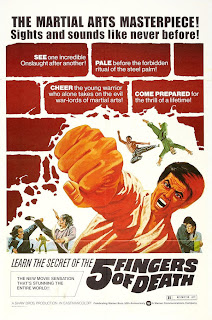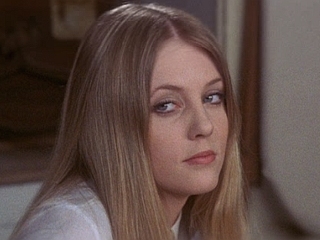AFED #111: Shào Lín sān shí liù fáng [The 36th Chamber of Shaolin] (Hong Kong, 1978); Dir. Liu Ch-Liang; Tian xia di yi quan [aka King Boxer, aka Five Fingers of Death] (Hong Kong, 1972); Dir. Cheng Chang Ho
Martial arts film are, it must be confessed, something of a blank area for me. Many years ago I recall being challenged by a friend when I suggested that Enter the Dragon was the best of this genre ever made. "You've never seen any others though," he pointed out. It's true, and until now I haven't made any attempt to redress this.
So let's start with a double bill produced by Hong Kong's most famous studio, the redoubtable Shaw Brothers. The name is synonymous with Kung Fu and martial arts cinema, almost representing a genre within the genre, cranking out dozens of films a year during their heyday in the seventies.
Modelled on the old Hollywood studio system, right down to the company logo (imitating that of Warners'), the company kept a stable of stars and directors under exclusive contract. It worked highly effectively although as the decade progressed Shaw would be eclipsed by a rough-and-ready rival, Golden Harvest, who launched the careers of many of the most famous martial arts stars (Bruce Lee, Jackie Chan, Jet Li) and was ironically formed by two former Shaw executives.
King Boxer and The 36th Chamber of Shaolin (I'll use the titles of the dvd releases) are considered amongst the best Shaw films, boasting an enthusiastic fan following. Tarantino lists the former amongst his all-time favourites, while my interest in 36th Chamber was piqued by its influence on rappers the Wu Tang Clan (RZA even contributes to the dvd commentary).
Both films star young heroes who must undergo physical and spiritual rites of passage in order to vanquish their oppressors. In King Boxer Chi-Hao (Lo Lieh) enters the tutelage of a new master, Shen Chin-Pei, in readiness for a forthcoming tournament in which he must defeat the local tyrant's son.
Learning quickly, Chi-Hao initiated into the secret of Shen Chin-Pei's mysterious 'iron fist' technique (presumably inspiring the Marvel hero of the same name) and earns the enmity of the master's previous favourite who sets him up for a clash with the villains, who in turn crush his hands. Chi-Hao must call upon all his reserves of determination in order to recover in time and win the tournament.
It's simplistic, comic-book stuff; garish visuals, variable acting, simplistic dialogue and regular displays of unfeasible acrobatics and superhuman fighting skills. Yet it's assembled professionally; although the sets betray it's mainly studio-based filming it's crisp cinematography is comfortably on a par with an American production.
Chi-Hao's training, the patience and resolve required to master skills, forms an important component of Kick Boxer, but for The 36th Chamber of Shaolin it's pretty much the raison d'être. The film is a fictionalised account of the legend of San Te, a disciple of martial arts at the revered Shaolin monastery during the eighteenth century.
In this version of the story San Te (Gordon Liu) is one of a group of a group of students who join their teacher into opposing the Manchu government (i.e. the ruling Qing dynasty). When his friends and family are killed San Te flees to the Shaolin temple, hoping they will teach him the techniques of kung fu.
During the long middle act he gradually moves through the different 'chambers', or colleges of learning, that are required to become a kung fu master. These range in complexity from learning to negotiate a water jump by stepping on a floating barrel to advanced fighting techniques. After several years of committed study and application he finally attains the top ranking, but rather than remain in the temple he requests to be allowed to form a new 36th chamber, dedicated to teaching kung fu to common folk.
Although less action orientated 36th Chamber does a good job of conveying the kung fu philosophy. San Te may be the most gifted student at the temple but the attainment of his goal is still only attained through great tribulation and endless repetition of the same exercises. Given the villains are effectively out of the picture for much of the film it could be painfully dull but we're drawn in to the hero's personal journey. Humour - in particular San Te's many pratfalls as he attempts to master the skills - plays an important part and Gordon Liu gives a charismatic performance in the lead.
So let's start with a double bill produced by Hong Kong's most famous studio, the redoubtable Shaw Brothers. The name is synonymous with Kung Fu and martial arts cinema, almost representing a genre within the genre, cranking out dozens of films a year during their heyday in the seventies.
Modelled on the old Hollywood studio system, right down to the company logo (imitating that of Warners'), the company kept a stable of stars and directors under exclusive contract. It worked highly effectively although as the decade progressed Shaw would be eclipsed by a rough-and-ready rival, Golden Harvest, who launched the careers of many of the most famous martial arts stars (Bruce Lee, Jackie Chan, Jet Li) and was ironically formed by two former Shaw executives.
King Boxer and The 36th Chamber of Shaolin (I'll use the titles of the dvd releases) are considered amongst the best Shaw films, boasting an enthusiastic fan following. Tarantino lists the former amongst his all-time favourites, while my interest in 36th Chamber was piqued by its influence on rappers the Wu Tang Clan (RZA even contributes to the dvd commentary).
Both films star young heroes who must undergo physical and spiritual rites of passage in order to vanquish their oppressors. In King Boxer Chi-Hao (Lo Lieh) enters the tutelage of a new master, Shen Chin-Pei, in readiness for a forthcoming tournament in which he must defeat the local tyrant's son.
Learning quickly, Chi-Hao initiated into the secret of Shen Chin-Pei's mysterious 'iron fist' technique (presumably inspiring the Marvel hero of the same name) and earns the enmity of the master's previous favourite who sets him up for a clash with the villains, who in turn crush his hands. Chi-Hao must call upon all his reserves of determination in order to recover in time and win the tournament.
It's simplistic, comic-book stuff; garish visuals, variable acting, simplistic dialogue and regular displays of unfeasible acrobatics and superhuman fighting skills. Yet it's assembled professionally; although the sets betray it's mainly studio-based filming it's crisp cinematography is comfortably on a par with an American production.
Chi-Hao's training, the patience and resolve required to master skills, forms an important component of Kick Boxer, but for The 36th Chamber of Shaolin it's pretty much the raison d'être. The film is a fictionalised account of the legend of San Te, a disciple of martial arts at the revered Shaolin monastery during the eighteenth century.
In this version of the story San Te (Gordon Liu) is one of a group of a group of students who join their teacher into opposing the Manchu government (i.e. the ruling Qing dynasty). When his friends and family are killed San Te flees to the Shaolin temple, hoping they will teach him the techniques of kung fu.
During the long middle act he gradually moves through the different 'chambers', or colleges of learning, that are required to become a kung fu master. These range in complexity from learning to negotiate a water jump by stepping on a floating barrel to advanced fighting techniques. After several years of committed study and application he finally attains the top ranking, but rather than remain in the temple he requests to be allowed to form a new 36th chamber, dedicated to teaching kung fu to common folk.
Although less action orientated 36th Chamber does a good job of conveying the kung fu philosophy. San Te may be the most gifted student at the temple but the attainment of his goal is still only attained through great tribulation and endless repetition of the same exercises. Given the villains are effectively out of the picture for much of the film it could be painfully dull but we're drawn in to the hero's personal journey. Humour - in particular San Te's many pratfalls as he attempts to master the skills - plays an important part and Gordon Liu gives a charismatic performance in the lead.





Comments
Post a Comment